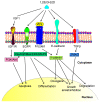Vitamin D May Protect against Breast Cancer through the Regulation of Long Noncoding RNAs by VDR Signaling
- PMID: 35328609
- PMCID: PMC8950893
- DOI: 10.3390/ijms23063189
Vitamin D May Protect against Breast Cancer through the Regulation of Long Noncoding RNAs by VDR Signaling
Abstract
Dietary vitamin D3 has attracted wide interest as a natural compound for breast cancer prevention and therapy, supported by in vitro and animal studies. The exact mechanism of such action of vitamin D3 is unknown and may include several independent or partly dependent pathways. The active metabolite of vitamin D3, 1α,25-dihydroxyvitamin D3 (1,25(OH)2D, calcitriol), binds to the vitamin D receptor (VDR) and induces its translocation to the nucleus, where it transactivates a myriad of genes. Vitamin D3 is involved in the maintenance of a normal epigenetic profile whose disturbance may contribute to breast cancer. In general, the protective effect of vitamin D3 against breast cancer is underlined by inhibition of proliferation and migration, stimulation of differentiation and apoptosis, and inhibition of epithelial/mesenchymal transition in breast cells. Vitamin D3 may also inhibit the transformation of normal mammary progenitors into breast cancer stem cells that initiate and sustain the growth of breast tumors. As long noncoding RNAs (lncRNAs) play an important role in breast cancer pathogenesis, and the specific mechanisms underlying this role are poorly understood, we provided several arguments that vitamin D3/VDR may induce protective effects in breast cancer through modulation of lncRNAs that are important for breast cancer pathogenesis. The main lncRNAs candidates to mediate the protective effect of vitamin D3 in breast cancer are lncBCAS1-4_1, AFAP1 antisense RNA 1 (AFAP1-AS1), metastasis-associated lung adenocarcinoma transcript 1 (MALAT1), long intergenic non-protein-coding RNA 511 (LINC00511), LINC00346, small nucleolar RNA host gene 6 (SNHG6), and SNHG16, but there is a rationale to explore several other lncRNAs.
Keywords: 1,25(OH)2D; VDR; breast cancer; lncRNA; miRNA; vitamin D3.
Conflict of interest statement
The authors declare no conflict of interest.
Figures



Similar articles
-
Vitamin D and systemic cancer: is this relevant to malignant melanoma?Br J Dermatol. 2002 Aug;147(2):197-213. doi: 10.1046/j.1365-2133.2002.04960.x. Br J Dermatol. 2002. PMID: 12174089 Review.
-
Expression analysis of vitamin D receptor-associated lncRNAs in epileptic patients.Metab Brain Dis. 2019 Oct;34(5):1457-1465. doi: 10.1007/s11011-019-00446-9. Epub 2019 Jun 11. Metab Brain Dis. 2019. PMID: 31187385
-
Abnormal pattern of vitamin D receptor-associated genes and lncRNAs in patients with bipolar disorder.BMC Psychiatry. 2022 Mar 12;22(1):178. doi: 10.1186/s12888-022-03811-8. BMC Psychiatry. 2022. PMID: 35279108 Free PMC article.
-
Evaluation of expression of VDR-associated lncRNAs in COVID-19 patients.BMC Infect Dis. 2021 Jun 19;21(1):588. doi: 10.1186/s12879-021-06248-8. BMC Infect Dis. 2021. PMID: 34147082 Free PMC article.
-
The role of vitamin D in breast cancer risk and progression.Endocr Relat Cancer. 2022 Jan 24;29(2):R33-R55. doi: 10.1530/ERC-21-0182. Endocr Relat Cancer. 2022. PMID: 34935629 Review.
Cited by
-
The Impact of Vitamin D and Its Dietary Supplementation in Breast Cancer Prevention: An Integrative Review.Nutrients. 2024 Feb 20;16(5):573. doi: 10.3390/nu16050573. Nutrients. 2024. PMID: 38474702 Free PMC article. Review.
-
Prevalence and Relevance of Vitamin D Deficiency in Newly Diagnosed Breast Cancer Patients: A Pilot Study.Nutrients. 2023 Mar 17;15(6):1450. doi: 10.3390/nu15061450. Nutrients. 2023. PMID: 36986179 Free PMC article.
-
Vitamin D Reshapes Genomic Hierarchies in Skin Cells: lncRNA-Driven Responses in Carcinoma Versus Transcription Factor-Based Regulation in Healthy Skin.Int J Mol Sci. 2025 Jul 10;26(14):6632. doi: 10.3390/ijms26146632. Int J Mol Sci. 2025. PMID: 40724881 Free PMC article.
-
Investigating Vitamin D3's anticancer mechanisms in MCF-7 cells: a network pharmacology and omics technology approach.Mol Divers. 2025 Mar 27. doi: 10.1007/s11030-025-11156-z. Online ahead of print. Mol Divers. 2025. PMID: 40146431
-
The emerging roles of LINC00511 in breast cancer development and therapy.Front Oncol. 2024 Aug 14;14:1429262. doi: 10.3389/fonc.2024.1429262. eCollection 2024. Front Oncol. 2024. PMID: 39206156 Free PMC article. Review.
References
-
- Choudhury H., Pandey M., Wen L.P., Cien L.K., Xin H., Yee A.N.J., Lee N.J., Gorain B., Amin M., Pichika M.R. Folic Acid Conjugated Nanocarriers for Efficient Targetability and Promising Anticancer Efficacy for Treatment of Breast Cancer: A Review of Recent Updates. Curr. Pharm. Des. 2020;26:5365–5379. doi: 10.2174/1381612826666200721000958. - DOI - PubMed
Publication types
MeSH terms
Substances
LinkOut - more resources
Full Text Sources
Medical
Research Materials

